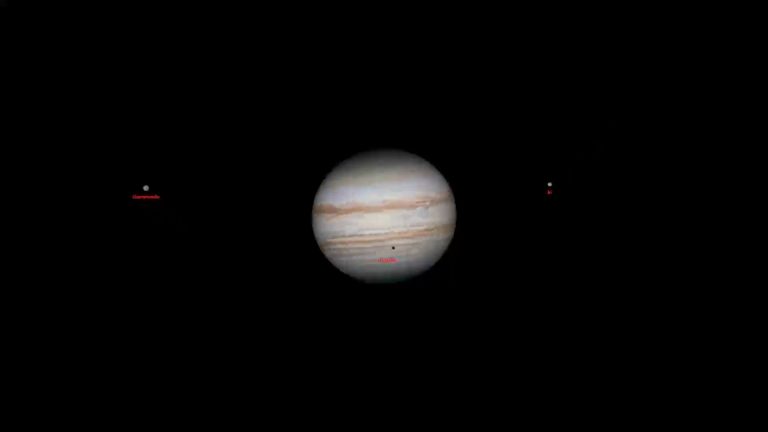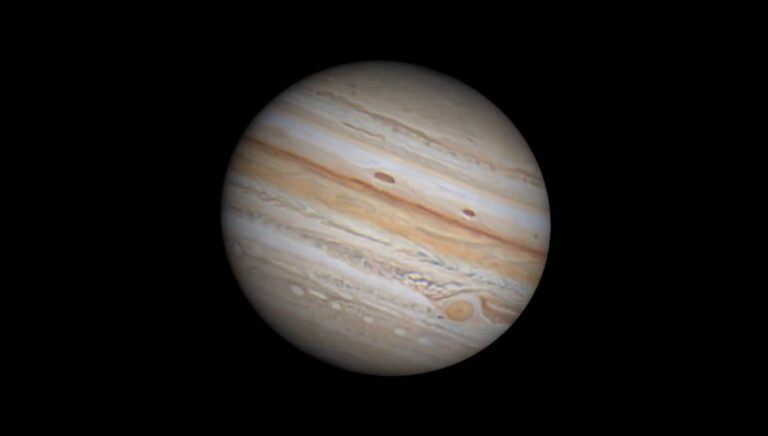火星车的影子
A red landscape filled with rocks is shown. A hilltop is visible in the distance. A shadow is visible on the landscape. Please see the explanation for more detailed information.
图为布满岩石的红色景观。远处可以看到一座山顶。在风景中可以看到阴影。有关更多详细信息,请参阅说明。

A red landscape filled with rocks is shown. A hilltop is visible in the distance. A shadow is visible on the landscape. Please see the explanation for more detailed information.
图为布满岩石的红色景观。远处可以看到一座山顶。在风景中可以看到阴影。有关更多详细信息,请参阅说明。

See Explanation. Clicking on the vedio will download the highest resolution version available.
请参阅说明。单击视频将下载可用的最高分辨率版本。

照片中的彗星有一条非常长的波浪形离子尾。彗星的前部——彗发——看起来是一个螺旋。彗发呈绿色,尾部呈淡蓝色,部分漩涡呈红色。有关更多详细信息,请参阅说明。

2024年1月19日 Jupiter over 2 Hours and 30 Minutes Image Credit & License: Aurélien Genin Explanation: Jupiter, our Solar System’s ruling gas giant, is also the fastest spinning planet, rotating once in less than 10 hours. The gas giant doesn’t rotate like a solid body though. A day on Jupiter is about 9 hours and 56 minutes long at the poles, decreasing to 9 hours and 50 minutes near the equator. The giant planet’s fast rotation creates strong jet streams, separating its clouds into planet girdling bands of dark belts and bright zones. You can easily follow Jupiter’s rapid rotation in this sharp sequence of images from the night of January 15, all taken with a camera and small telescope outside of Paris, France. Located just…

2022年10月25日 Jupiter Rotates as Moons Orbit Video Credit & Copyright: Makrem Larnaout Explanation: Jupiter and its moons move like our Sun and its planets. Similarly, Jupiter spins while its moons circle around. Jupiter’s rotation can be observed by tracking circulating dark belts and light zones. The Great Red Spot, the largest storm known, rotates to become visible after about 15 seconds in the 48-second time lapse video. The video is a compilation of shorts taken over several nights last month and combined into a digital recreation of how 24-continuous hours would appear. Jupiter’s brightest moons always orbit in the plane of the planet’s rotation, even as Earth’s spin makes the whole system appear to tilt. The moons Europa, Ganymede, and Io are all visible, with…

2021年10月26日 Jupiter Rotates Video Credit & Copyright: JL Dauvergne; Music: Oro Aqua (Benoit Reeves) Explanation: Observe the graceful twirl of our Solar System’s largest planet. Many interesting features of Jupiter’s enigmatic atmosphere, including dark belts and light zones, can be followed in detail. A careful inspection will reveal that different cloud layers rotate at slightly different speeds. The famous Great Red Spot is not visible at first — but soon rotates into view. Other smaller storm systems occasionally appear. As large as Jupiter is, it rotates in only 10 hours. Our small Earth, by comparison, takes 24 hours to complete a spin cycle. The featured high-resolution time-lapse video was captured over five nights earlier this month by a mid-sized telescope on an apartment balcony in…